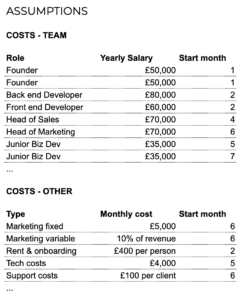The post How to budget as an early-stage startup appeared first on Beyond.
]]>Now is the time to show future investors they can trust you by building a beautiful budget – because naturally, you know what you’re doing!

Exciting possibilities lie before you – how are you going to allocate your funds? How much to hiring? Product? Marketing? Unlimited coffee?
This is where the trusty spreadsheet comes in… an inevitable recurring character for all startups.
1) Expense budgeting
For each cost, write down the amount and the month it starts. So if you’re hiring a software engineer, you’d write their annual salary and the month you plan to hire them. Once all your lines are written down, the magic of spreadsheets lets you automatically break this down into monthly costs.
2) Revenue budgeting
Do the same for your revenue plan. Divide it into different lines representing your income sources, factoring in all the stuff you tried to forget from school: customer acquisition costs, expected growth rate per channel, recurring versus one-off revenue etc. Add in any one-off cash injections like the money you managed to convince your elderly neighbour to ‘invest’.
Tips and tricks
When building expense and revenue budgets, you can make things more complicated (and thus more impressive!) by using drivers, formulas and percentages.
For example, you might want your marketing to scale with a percentage of your revenue, your support and infrastructure costs to scale with your number of clients, or your rent and onboarding costs to scale with number of employees.
3) Bringing it all together
One handy way to do this is to use multiple spreadsheet tabs with your different assumptions, and a tab putting everything together within a monthly view. Here you want a line subtracting your expense from your revenue (this is your profit/ loss), and a line that adds up this line cumulatively to get your ending balance.

Now you can work out some key budgeting stats:
- Runway: the month before all goes to shit and you run out of money.
- Cashflow positive: the month when you can organise a massive party because YOU’RE MAKING A PROFIT!!!
From this you can decide if you need to tweak your budget (eg decrease expenses), when to budget more expenses (eg new hires), when to raise a round (once you’ve proved scalability but far in advance of your max runway month), and when to despair.
Tracking your budget (rather than let it rot in your Google Drive)
As founder of an early-stage startup, you get the amazing privilege of coming in every month or so and course-correcting assumptions: increasing expenses when your junior BizDev accidentally miss-types an extra 0 in their ad campaign cost, or increasing revenue projections after managing to convince a client to sign up for the “Ultra-Premium” package.
A good practice here is to copy your budget before you adjust it, so you can keep track of how terrible your predictions are over time. You can get expenditure and revenue data from your accounting system or, because there’s few actuals at this stage, directly from your bank.
Crucially this is a chance to adjust your strategy as you go, rather than blindly charge into a wall. If you’re making a lot less revenue than expected, you might want to delay expenditure. If you’re making more, you want to accelerate instead. If your runway date starts to loom closer and your revenue is nowhere near your predictions, it’s time to re-evaluate your (company’s) life.

Good luck, and happy budgeting!
About me:
I’m the founder of Beyond, providing budgeting software for fast-moving SMEs. Beyond automates the day-to-day, so budget holders and finance teams can spot risk and confidently plan for the future.
The post How to budget as an early-stage startup appeared first on Beyond.
]]>The post Feature spotlight: drivers appeared first on Beyond.
]]>Any planning that relies on a changeable figure – like a head count for personnel costs or an exchange rate for currency conversions – will work best as a driver.
Creating and managing drivers
On Beyond, drivers are created and managed by power users. Only power users can add and amend drivers, though managers are able to see them and add them into their reports.
Whenever a driver number has to change, it can be changed once – and every plan which uses it will be automatically updated.
(Don’t worry – we’ll let you know what’s going to change!)
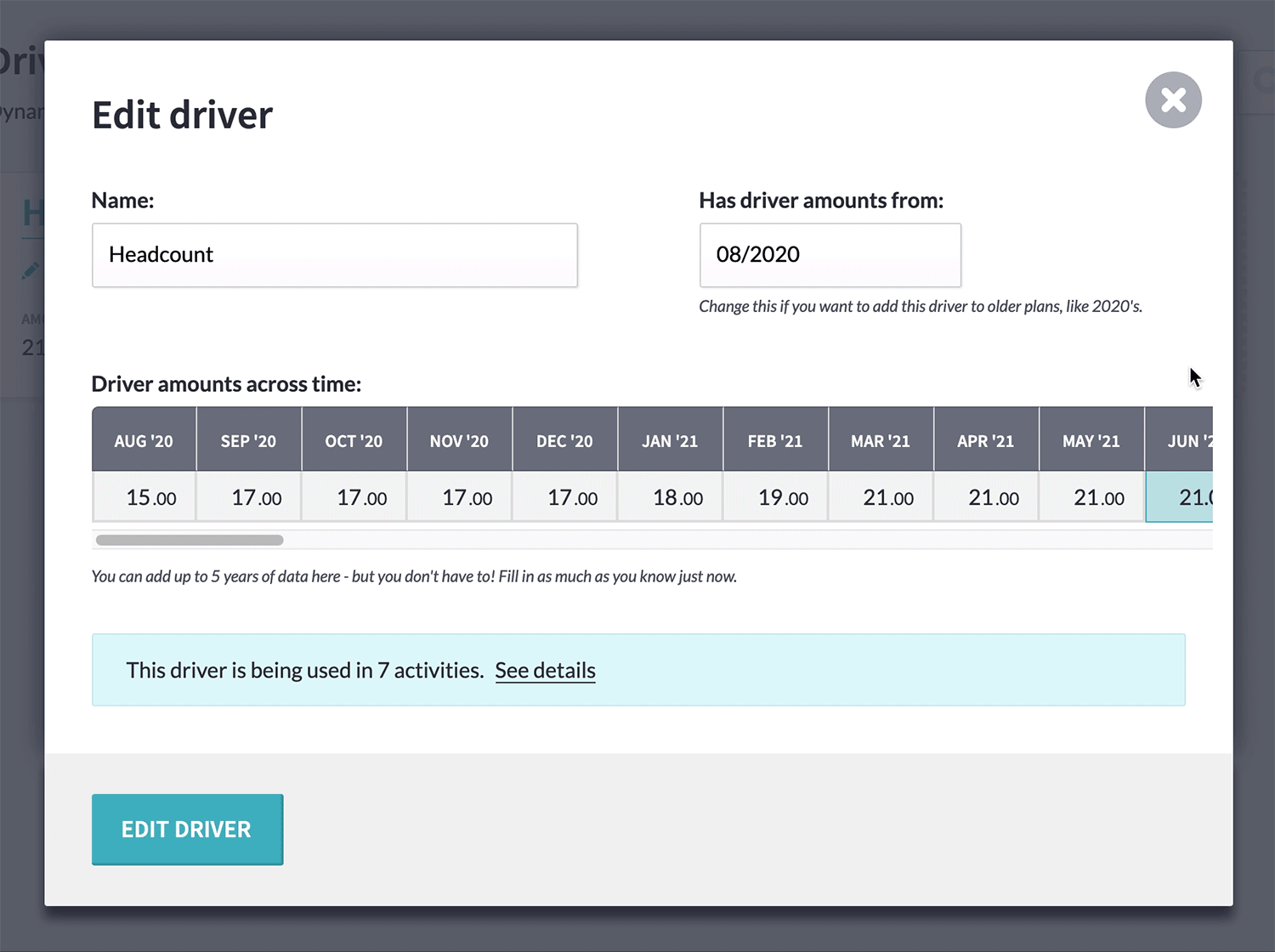
And the historical data won’t be changed. A driver can have up to five years’ worth of figures, broken down into monthly amounts, allowing you to keep your current and upcoming budgets up-to-date without affecting last year’s budgets.
Drivers are created and managed on the new ‘drivers’ page under ‘settings’. Try setting one up now.
Using drivers in activities
Power users and managers can add drivers into activity allocations or forecasts by clicking the ‘add drivers’ button on an activity’s monthly breakdown.
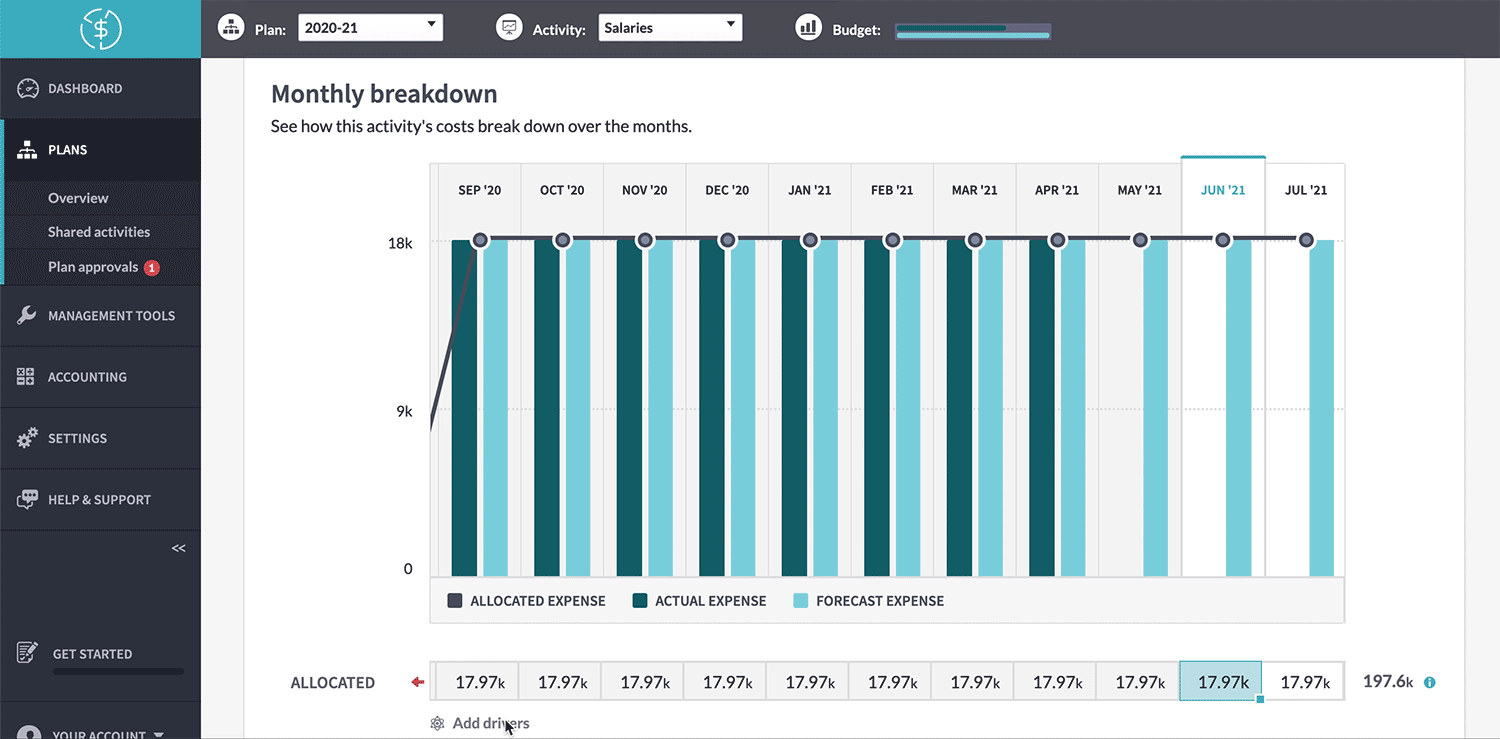
This will bring up a window where you can build a formula using drivers. That might be something like 100 x head count – where 100 is a per-person cost – or 1 x dollar conversion – where 1 is 1 GBP being converted to USD.
You can also build more complex formulas by adding, multiplying, dividing, or subtracting driver values.
Once you’ve created your formula, it will be applied to every month in your activity.

Similar to how adding a forecast row changes the breakdown, showing a total and then each individual forecast row, adding drivers will change the ‘allocated’ or ‘forecast’ row to an uneditable summary. The detail will be in two new rows underneath it – ‘driver’, showing the driver amount per month, and ‘manual’, which will let you add in extra figures, outside the driver.
If you want to remove a driver from a month or change its formula, you can click into an individual month to make changes, and drag those changes across the surrounding months.
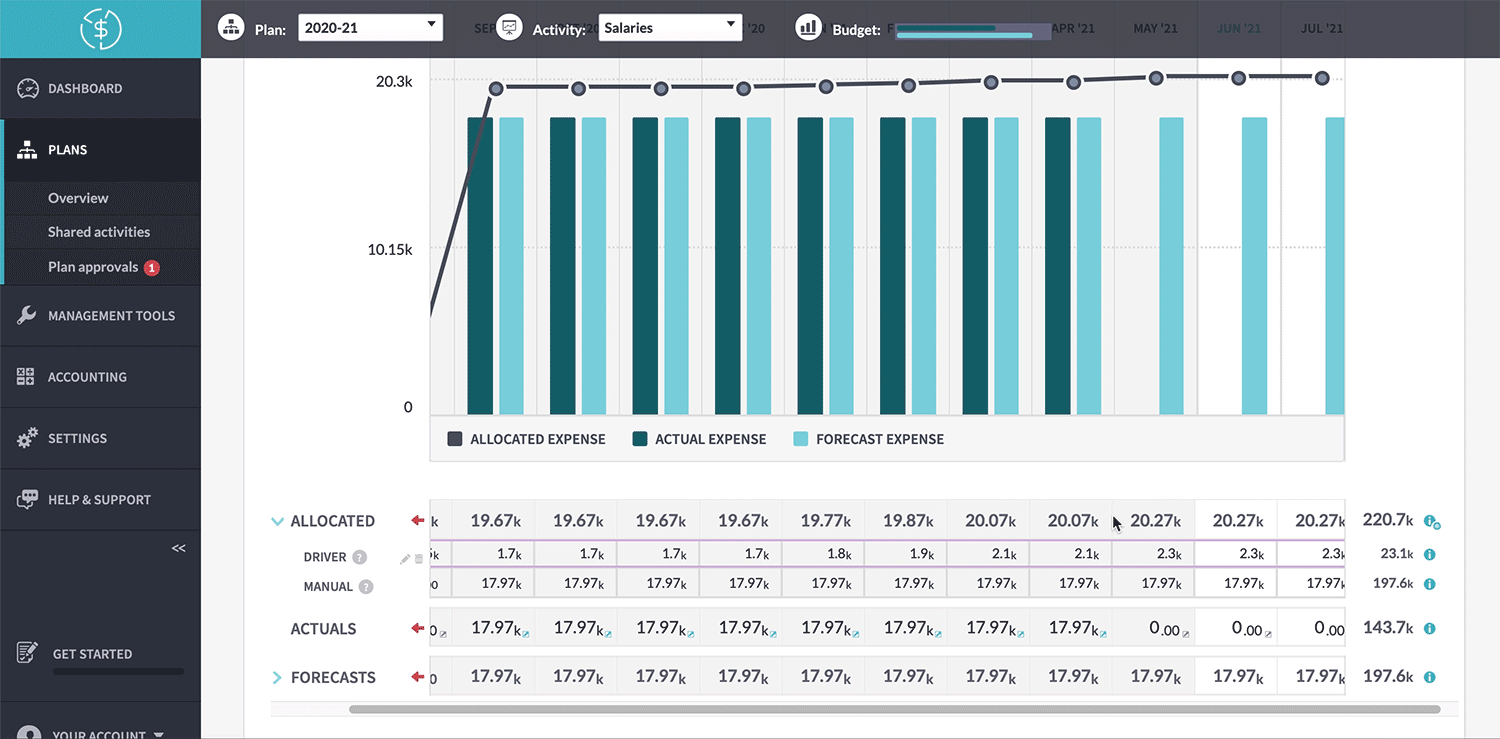
We’ll always hide the details when you go onto an activity page (save you scrolling!) but you can click on the blue arrow on the left or anywhere on the summary row to see the full breakdown.
Try adding drivers to your budgets now and bring your planning to the next level!
The post Feature spotlight: drivers appeared first on Beyond.
]]>The post COVID-19 has thrown us all off track. <br/>Let’s get you back on. appeared first on Beyond.
]]>
Beyond exists to help businesses navigate change, to enable them to make the most effective use of their resources and to keep employees in the loop no matter where they are.
Right now, being able to do these things fast and well is more crucial than ever.
We’ve been thinking how we can help as many businesses as possible work through the challenges and upheaval caused by COVID-19.
So we’ve decided to give all new accounts free, unlimited access to the full Beyond platform until the 1st of August, 2020.
There are no catches and no obligations. You don’t even need credit card details.
If you need a platform to help plan, track, and manage your financial changes, or are making the most of a quieter period of business to improve your processes, we want to help.
Sign up now at headbeyond.com – no strings attached.
Update from Beyond HQ
I’m happy to report that first and foremost the Beyond team is safe and well. As a part-remote team already we have adapted fairly easily to this brave new world – we are ready to support our clients through their own challenges.
In related news, we’re also fast-tracking a suite of new features we’ve been working on to help at this turbulent time. Scenario planning, driver-based forecasting and a host of other functionality will be making their way to Beyond very soon. Watch this space.
Keep safe, and keep washing those hands!
The post COVID-19 has thrown us all off track. <br/>Let’s get you back on. appeared first on Beyond.
]]>The post Activity Categories: new dimensions of budgeting appeared first on Beyond.
]]>Being able to answer these questions in real-time already places you many steps ahead of most businesses, but we can do even better.

How about being able to answer these questions?
- What’s my monthly spend on travel and how does it compare to other categories?
- How do my revenue and costs compare across locations?
- How much per year is going towards business-as-usual versus strategic work?
- What is the budget variance for my key programmes across the business?
These questions, and many more, can now be answered with the powerful new view added to the Budget Explorer:

And this view is just the start – from here you can click into any category and drill down to the underlying activities, actuals and forecasts that drive it. Very cool.
These views are made possible by the use of ‘Activity Categories’. They’re extremely flexible – think of any category or dimension you’d like to tag activities with (like Location, Programme, Type, Client, Goal…) and list the different values this category can take. Then whenever any user creates an activity, they’ll be able to choose which category value to tag that activity with.

In only a few clicks, you can ensure every relevant activity is tagged by the categories that make sense to you. Tracking budgets and managing activities across the business just got a whole lot easier.
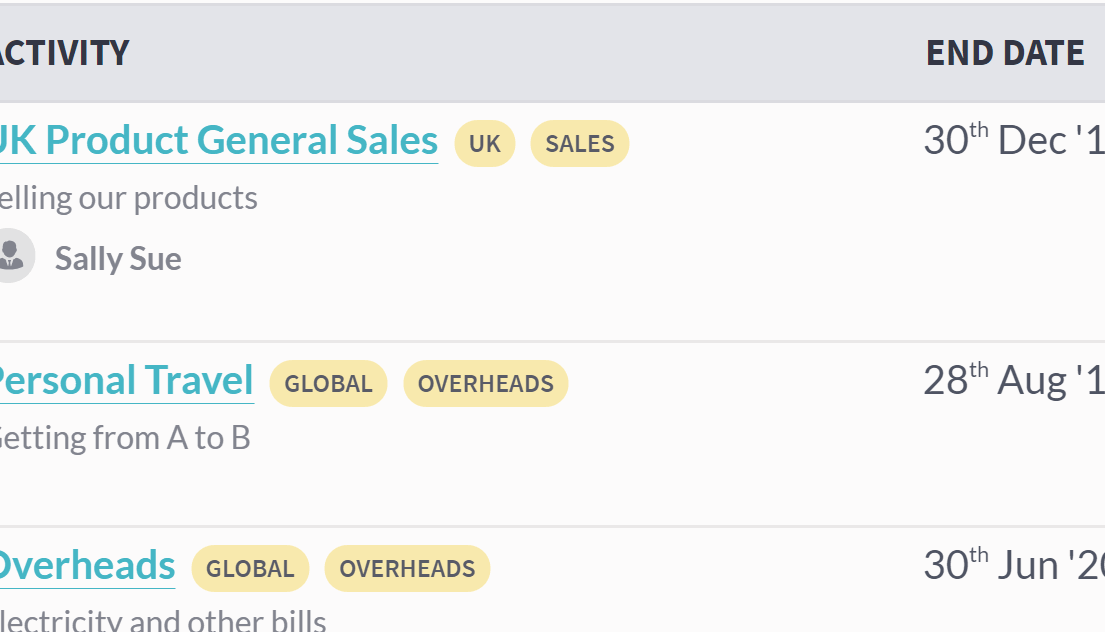
Happy tagging!
Of course, the Budget Explorer view and the underlying Activity Categories are both completely customisable, so you can slice, dice, breakdown and summarise based on your precise business needs (and update them as they change).
With Beyond, you’re always in control.
The post Activity Categories: new dimensions of budgeting appeared first on Beyond.
]]>The post CFO Secrets: Effective budgeting for SMEs appeared first on Beyond.
]]>So, how can a business budget effectively? A budget is most effective when all its budget holders work collaboratively alongside the finance function. The more involved budget holders are in creating their budgets, the higher the likelihood they will be engaged in the whole process and indeed be inclined to work harder to ensure budgets are met and exceeded.
Getting started

Although budgets are a forecast of expected income and expenditure, we can use historic performance as a baseline to check assumptions we are making when producing our budgets. It can be difficult to predict future revenue especially for businesses working on a project by project basis. Gross profit margins can vary between projects. Overspending is often inevitable when staff need to meet a brief and just get things done.
Past data can be a great starting point for your new budget. Due to the increase of artificial intelligence and automation within finance, budgeting is more insightful and accurate than ever before. However, there is always an element of uncertainty to consider, especially for new businesses who haven’t yet accumulated any past data for insights on expected performance, or those entering a new market. Even the slightest change within a small business can impact the financial future of the company. For example, government legislation changing minimum wages or pension contributions which are out of your control need careful consideration and planning.
Understanding the risks

It’s crucial to understand your current situation and, so, be able to pre-empt any risks in your business model. There are always unexpected costs that arise throughout the course of operations and having a contingency within your budget can help absorb these risks. Preparing your budget with these unexpected costs in mind, (such as equipment needing to be repaired or replaced) will keep your planned expenditure as realistic as possible. Once a stable yet realistic budget has been agreed, the regular monitoring of progress against this becomes critical for the full process to be effective.
Keeping on track

Producing budget vs actual reporting can highlight variances at an early stage to give a company opportunity to address what has caused any overspend or difficulties meeting the revenue forecasts. This constant check against budget proves to be a valuable piece of management information to monitor financial health and performance for company owners, shareholders, budget holders, the finance team and wider business.
Change is the only constant

Budgets are never static, they evolve and change over time. By re-visiting your budget at regular intervals and adjusting it accordingly, the more accurate your budget becomes. This will enhance the power it gives the business to make those important financial decisions. So, what are you waiting for?
The post CFO Secrets: Effective budgeting for SMEs appeared first on Beyond.
]]>The post Rethinking the finance function in the age of robots appeared first on Beyond.
]]>Coming for our data, coming for our jobs, and (if the more dramatic reports are to be believed) coming for our very existence.

Or are they?
Let’s pick apart the A.I. fact from the hype and see where the real opportunities lie for the future finance function.
They are already here
A.I. is already transforming core functions of a typical accountant. Repeated processes based on structured data are ripe for automation. Things like:
- Invoice chasing
- Matching and reconciling transactions
- Invoice coding
- Anomaly and fraud detection
After all, A.I. is measurably faster and more accurate than us fleshy meat-bags at these repetitive tasks. And besides, this work is pretty boring anyway…
They are getting smarter
Nerves start to jangle when we see the next wave of intelligence starting to be deployed. Recent advancements in natural language processing and machine learning helps A.I. deal with both the nuances of text and the ever-present ambiguity of a business’s finances. This brings a far greater swathe of traditional accountancy work into reach. We are starting to see:
- Fully automated bookkeeping
- Advanced report creation and statutory filings
- Analysis of legal and tax documents
- Deep predictive analytics
- Smart audit assistants
Certainly starting to encroach on some classic value-add activities of a typical finance function.
[You don't need to see another generic yet ominous picture of a robot using a keyboard]
(what kind of self-respecting robot needs to use a keyboard anyway...??)
Expectations are changing
People’s beliefs of what technology can do for us is fundamentally changing. Across almost all industries, there is a growing expectation that automation will be bundled along with core services. As we shop online, we expect to see helpful recommendations; as we get into a car we expect it to direct us to our destination (and soon to take us there altogether); as we bank we expect to get smart alerts and reminders.
Accounting is no different. There will, of course, be adjustments needed as traditional tasks are commoditised and old revenue streams dry up, but this also raises huge opportunities. This is not a zero-sum game.
A prosperous co-existence
In a business context, A.I. is nothing without people.
While A.I. unlocks accounting superpowers, finance professionals are needed to put them to good use. Tool selection and setup, ongoing interpretation and tuning, and – of course – accountability are all roles which will need a human touch for the foreseeable future. After all, with great power comes great responsibility.
More importantly, as accountants’ time is freed up from menial tasks, they can shift their focus to a higher level, the strategic objectives of the company. Advisory services will become a fertile and lucrative hunting ground. Goodbye business policeman, hello business partner.

Power to the people
Vendors will often say you just need a smart new machine learning tool or shiny dashboard to gain a magical insight into a business. However, as any good A.I. engineer will tell you, an algorithm is only as good as the data it has access to.
This means, when trying to truly understand the workings of a business, you have to engage the real driving force – its people. Their knowledge, understanding of risks and plans for the future are always essential for true insights.
Here, A.I. can be an enabler – removing bottlenecks and giving people superpowers.
And ultimately it is a tool of empowerment – helping information flow more freely and enlightening decision-making.
Not so scary after all.
Bringing this to life
In order to build this deep partnership, it’s essential that your systems:
- Truly understand the business at its most granular level – its people and the context of all activities across the organisation.
- Always contain the most up-to-date data, link with all your tools, and can quickly flag issues, anomalies and opportunities as – or before! – they arise.
- Enable the company to quickly act on the decisions that can be made from this data.
We’ve created Beyond around these exact demands, deploying A.I. in a way that puts people – not robots – at the centre.
This post originally appeared as an article on AccountingWeb
The post Rethinking the finance function in the age of robots appeared first on Beyond.
]]>